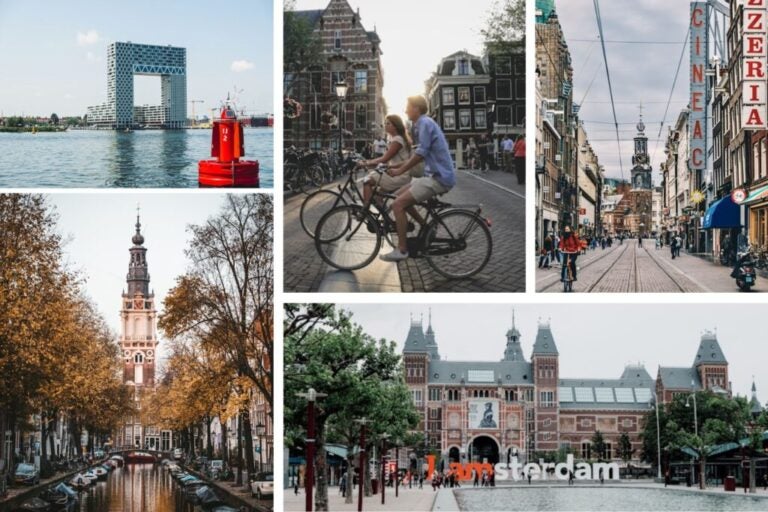Accommodation in Amsterdam for long-term stays as a digital nomad
Discover the best neighbourhoods and areas to stay in Amsterdam. We’ll tell you what each one offers — from coliving spaces to fully furnished apartments.
If you’re planning a long stay in Amsterdam —whether to work remotely, study, or simply enjoy a change of scenery— finding the right accommodation will be key to your experience. The charming Dutch capital is one of the top destinations for digital nomads worldwide. And this guide on accommodation in Amsterdam for long-term stays is the first tool to help you plan your move to the land of canals and windmills.
Unlike a short tourist trip, staying several weeks or months in a new city requires proper planning. For example, you’ll need to find out which neighbourhoods are best, what types of accommodation suit the digital nomad lifestyle best, and where to live and work comfortably, among other details.
Today, we’ll tell you everything you need to know about where to stay in Amsterdam for an extended period. We’ll talk about the most convenient areas, the best accommodation types, and share a few practical tips to help you settle in easily. Will you join us?
Where to stay in Amsterdam for a long-term stay
Travelling to Amsterdam for a few days isn’t the same as doing it for months (or even years). In the first case, you can sort accommodation without much trouble. After all, you’ll spend more time exploring the city than staying indoors. But for longer stays, it’s important to evaluate different areas, comfort, safety, and other key aspects.
Luckily, Amsterdam is very friendly to those looking to stay for a while. If you live a nomadic lifestyle, you’ll find plenty of options for different budgets and ways of living. Below, we’ll show you some of the most popular choices.
Coliving in Amsterdam
Coliving spaces bring together digital nomads, remote workers, entrepreneurs, and even students from all around the world. They combine coworking areas with private and shared living spaces, encouraging community life while respecting privacy. Staying in a coliving can be an enriching experience —perfect for making new friends, networking, and saving some euros (€).
In Amsterdam, there are modern coliving spaces combining accommodation with coworking zones, social activities, and an international community. Workspaces include desks, ergonomic chairs, dedicated areas for video calls, and ultra-fast Wi-Fi. Private and shared rooms are move-in ready. Some colivings also include extras like laundry services, rooftop terraces, and weekly community events.
- Coliving prices in Amsterdam depend on the area, location, and length of stay. A private room usually costs between $970–1,600 (€900–1,500), while shared rooms are around $700 (€650).
Want to know more? Don’t miss our guide to the six best colivings in Amsterdam. You’ll surely find one that fits your needs!
Furnished apartments
Fully equipped apartments are another popular long-term accommodation option in Amsterdam. Like colivings, they can be rented monthly or weekly, offering great flexibility. But if community life isn’t your thing, this option gives you privacy and your own space to work. Just bring your luggage and start enjoying your stay without any hassle.
- Prices vary according to the neighbourhood and apartment size, but studios are the most in-demand option. A studio or single-room flat usually costs between $1,300–2,200 (€1,200–2,000), while two-bedroom flats start from $2,200 (€2,000).
Airbnb for seasonal stays
Many Airbnb hosts in Amsterdam offer discounts for long stays. Although prices may be higher than other options, some properties stand out for their design, location, or extra services. It’s a great alternative for those who value comfort and prefer a personalised experience.
- The price of a studio rented through Airbnb in Amsterdam ranges between $1,400–2,300 (€1,300–2,200), while a complete flat starts at $2,200 (€2,000) per month.
Student and young professional residences
Looking for where to stay in Amsterdam without spending too much? Some residences offer private rooms with shared kitchens, common areas, and study or work spaces. They’re comfortable, all-inclusive, and designed for stays over a month, perfect for tighter budgets.
- The price of a single room ranges between $760–1,200 (€700–1,100).
Stay connected throughout your stay in Amsterdam
As a digital nomad, you know how essential it is to have a reliable internet connection. Amsterdam, and the Netherlands in general, enjoy one of Europe’s most advanced networks, both in speed and coverage. This means you can work from anywhere in the city —a café, a coworking space, or your accommodation. Still, to avoid relying on Wi-Fi, our Netherlands eSIM gives you unlimited, high-speed data wherever you are.
However, for an even better experience, we recommend the monthly plans from Holafly. This service works through an eSIM that covers over 170 countries, including the Netherlands. So, you won’t need to buy a new eSIM if you’re travelling to other parts of Europe.
You just need to choose between a 25 GB plan or unlimited data, depending on your needs. The best part? There are no hidden fees, and you can cancel anytime. Without a doubt, Holafly is ideal for travellers who move from city to city and need constant connectivity.
Important: If you are a frequent traveler and want to stay connected without worrying about expensive roaming or looking for a new SIM at every destination, Holafly’s subscription plans are for you. With a single eSIM, enjoy internet in more than 160 countries for a fixed price and no surprises on your bill. Travel without limits and connect easily and securely! 🚀🌍

Where to stay in Amsterdam: Best districts and areas for a long stay
There are plenty of reasons why Amsterdam attracts visitors from all over the world —its historic streets lined with canals, old-world architecture, vibrant nightlife, and delicious food scene. This Dutch city is made up of unique districts that have everything, from medieval churches to fine dining restaurants, cosy cafés, and buzzing clubs. Since it’s such a popular destination, finding a quiet area to stay in Amsterdam can be a bit tricky, but there are many good options.
Each neighbourhood in Amsterdam has its own personality. Choosing the right one can truly shape your experience. While some stand out for their lively culture and entertainment, others are known for peace and local life. Some districts are perfect for digital nomads who want cafés and coworking spaces nearby.
Below, you’ll find the most recommended areas to live for a few months in the Dutch capital.
De Pijp
De Pijp is Amsterdam’s bohemian heart —a multicultural and lively neighbourhood filled with charm. Street markets, cosy cafés, and stylish coworking spaces blend perfectly, creating a unique atmosphere. De Pijp is home to spots like Albert Cuypmarkt (the city’s most famous open-air market), the Heineken Experience for beer lovers, and Sarphatipark, a peaceful green escape.
Another big plus is its excellent transport links. Metro line 52 (Noord/Zuidlijn) takes you to the city centre or Amsterdam Noord in just minutes. Several tram lines also run through the district, connecting it to the rest of the city.
- Recommended coliving spaces in De Pijp: If you’re looking for a coliving here, The Social Hub Amsterdam City is one of the best options. Technically located on the border between De Pijp and Oost, it’s still perfect for digital nomads who want to stay close to the area’s vibrant vibe.
- Furnished apartments in De Pijp: Here, you’ll also find studios and one-bedroom flats with equipped kitchens and bright spaces. Some offer flexible contracts, ideal if you’re not sure how long you’ll stay. A good example’s City Retreat, offering one-bedroom apartments from $2,900 (€2,700) per month.
Where to stay in Amsterdam: Jordaan District
If you’re after a quieter area that’s still well connected, Jordaan is ideal. With narrow canals, antique markets, and a relaxed vibe, it’s one of the most charming neighbourhoods for a long-term stay in Amsterdam.
Did you know Anne Frank’s House is located here? It’s one of the city’s most important historical landmarks and worth visiting. You can also stroll around Westerkerk or explore art galleries and vintage boutiques in the area.
Jordaan’s just a short walk from the city centre, making it a strategic location. Getting around the neighbourhood on foot’s very easy (you can even reach other parts of the city). You can also use one of the several tram lines (such as 13, 14, and 17) that run through the area and connect to all of Amsterdam.
- Recommended coliving spaces in Jordaan: They’re few but cosy, with friendly communities. One good example is Outside Amsterdam, located in a renovated traditional Dutch house.
- Hotels in Jordaan: If you’re looking for hotels in Jordaan, a good option’s Mercier, a four-star hotel in a very quiet part of the neighbourhood. Linden Hotel also stands out, located very close to the Anne Frank House, as well as Amsterdam Wiechmann Hotel, set in three restored canal-side houses.
Amsterdam Oost
Amsterdam Oost has grown a lot in recent years. It’s a youthful, vibrant area full of local life and lower prices than the city centre. Attractions like the Tropenmuseum, Oosterpark, and an exciting food scene make this district one of the best places to stay in Amsterdam. Its cultural mix also gives it an authentic and welcoming feel.
Oost is very well connected, with multiple tram lines and two train stations —Muiderpoort and Amstel— that make it easy to move around Amsterdam or even visit other Dutch cities.
- Recommended coliving spaces in Amsterdam Oost: Several new colivings have opened recently, such as The Cohesion – Amstel in the Amstelkwartier area, and OurDomain Amsterdam, located near Diemen. Also, OurDomain Amsterdam, located on the border with the Diemen district.
- Hotels in Amsterdam Oost: For those who prefer hotel comfort, Stayokay Amsterdam Oost’s a great choice. It has spacious rooms ideal for long stays, plus a bar, rooftop terrace, restaurant, and other amenities. Another excellent choice is Hotel Arena, right next to Oosterpark —great for working close to nature.
Amsterdam Noord
This dynamic district is another top choice for long-term stays in Amsterdam. Located across the IJ River, it’s a modern and eco-friendly area. It’s perfect for art and architecture lovers, where former factories and warehouses have been turned into cafés, hotels, and creative spaces.
In Amsterdam Noord, you can visit attractions like A’DAM Lookout —offering panoramic views and Europe’s highest swing— or explore NDSM Wharf, a former industrial zone now transformed into a cultural and artistic hub.
Although it feels a bit separate, Amsterdam Noord is well connected to the rest of the city. The reason’s a free ferry that crosses the IJ in just a few minutes from Central Station. Also, metro line 52 connects Amsterdam Noord with the centre in under ten minutes.
- Recommended coliving spaces in Amsterdam Noord: As expected, some are in converted industrial buildings. They have a more alternative style, focused on sustainability and community. One option’s ClinkNOORD, where you’ll find both accommodation and a diverse community that organises regular activities. Its proximity to the ferry connecting with the city centre makes it a practical and accessible option.
Where to stay in Amsterdam: Westerpark
Westerpark is ideal for those who want to combine urban life with green spaces. It’s less touristy than other areas, offering a peaceful lifestyle while staying well connected. The neighbourhood takes its name from one of Amsterdam’s largest and prettiest parks. Here you’ll also find Westergasfabriek, a cultural complex hosting markets, concerts, and events.
Several tram and bus lines connect Westerpark to the city centre in under fifteen minutes. It’s also perfect for cycling —one of the favourite transport modes among locals— thanks to its safe and well-marked bike lanes.
- Recommended coliving spaces in Westerpark: Some have started to open here, taking advantage of the relaxed atmosphere. These spaces focus on sustainability and community, perfect for those who value nature and well-being.
- Furnished apartments in Westerpark: There are plenty of studio and mid-size flats in quiet residential areas. Many modern buildings include terraces, bike storage, and utilities within the rent.
Oud-West
Oud-West is another excellent district to stay in Amsterdam. Filled with boutiques, stylish cafés, and leafy streets, it offers a genuine local feel —perfect for longer stays. Highlights include Vondelpark, the city’s most famous urban park, and Foodhallen, a trendy indoor gourmet market popular with both locals and tourists.
Getting around is easy, as several tram lines pass through Oud-West, connecting it to the city centre and other main districts within minutes.
- Recommended coliving spaces in Oud-West: This area features boutique colivings designed for creative professionals. They offer warm atmospheres, calm coworking zones, and weekly community events.
- Furnished apartments in Oud-West: You’ll find a variety of options, from small studios to large, character-filled flats in historic buildings. It’s perfect for those wanting to live like a local, away from tourist crowds.

Now that you’ve got a clearer idea of where to stay in Amsterdam, you can start looking for a place that matches your budget. Spending some time in the Dutch capital lets you enjoy everything this beautiful city offers. Bike rides, canal tours, brewery experiences, and lively nightlife await you there.
Frequently Asked Questions about where to stay in Amsterdam
What’s the minimum stay for long-term accommodation in Amsterdam?It depends on the property. Many colivings and flats offer monthly rentals without long contracts, while others require at least two or three months.
What documents do I need to rent a furnished flat?You’ll usually need to show ID, pay a security deposit, and provide proof of income. Students can also show a university acceptance letter, although it’s not mandatory.
Is Amsterdam an expensive city for digital nomads?Compared with other European cities, it is indeed an expensive city. Even within the Netherlands, it’s one of the priciest places to live. Still, choosing the right district and sharing housing can help you keep a reasonable budget. Public transport and cycling also reduce expenses.
Which areas should I avoid if I want a quiet stay?Amsterdam is lively and full of tourists. If you plan to stay longer, avoid the busiest parts. The historic centre and the Red Light District are the noisiest and most expensive areas. For peace and quiet, try Jordaan, Westerpark, or Amsterdam Noord.
What’s the difference between coliving and other types of accommodation?Colivings mix housing with community and practicality. They’re great for digital nomads who want flexibility and connection. Unlike hotels, they offer monthly rates that include Wi-Fi, coworking spaces, and networking events. Compared with traditional flats, you won’t need a long lease and most utilities are included.





 Language
Language 


















 No results found
No results found







